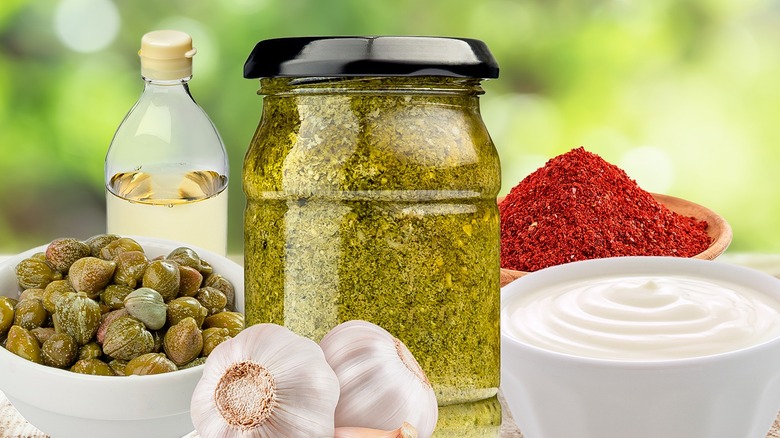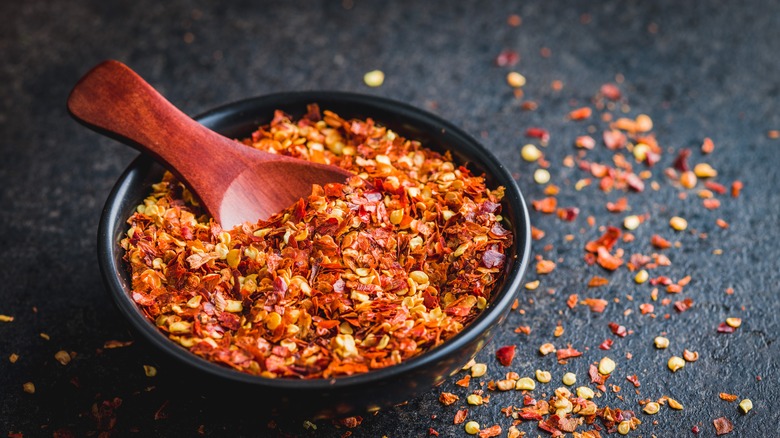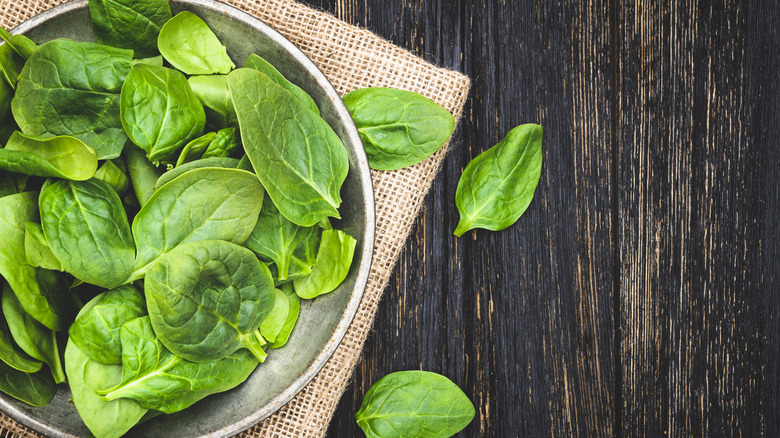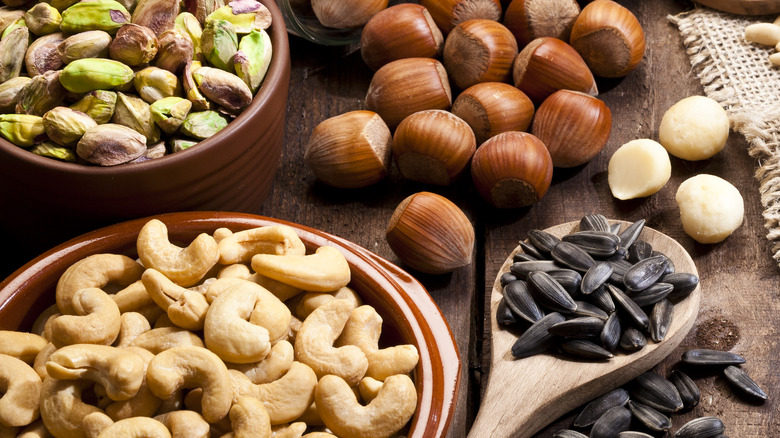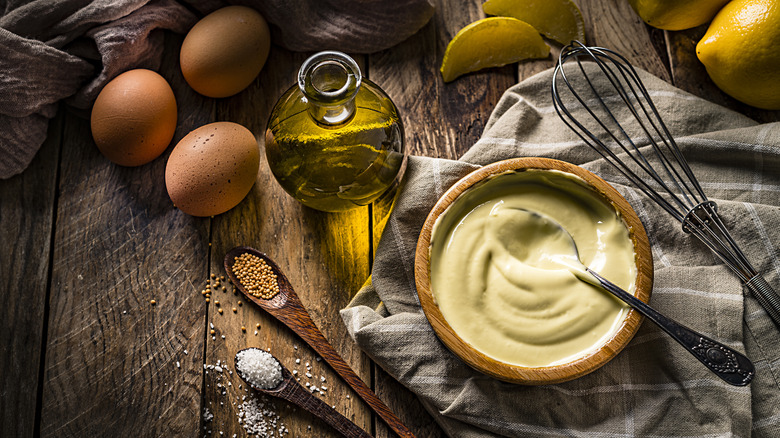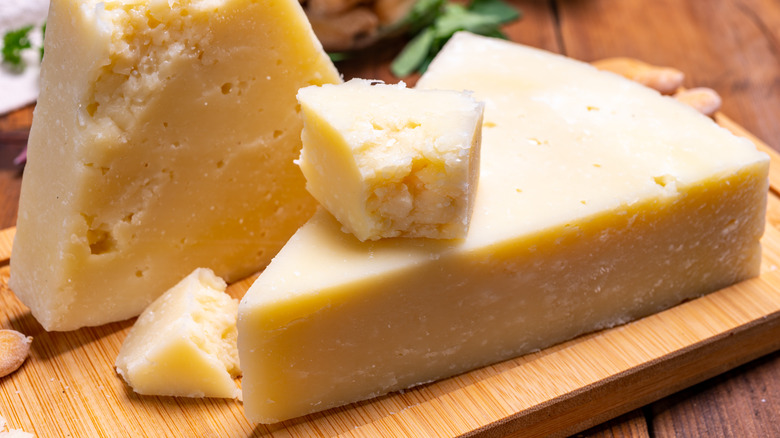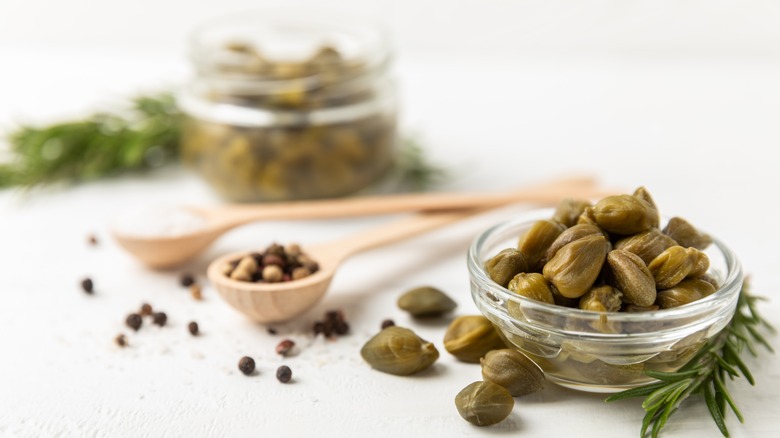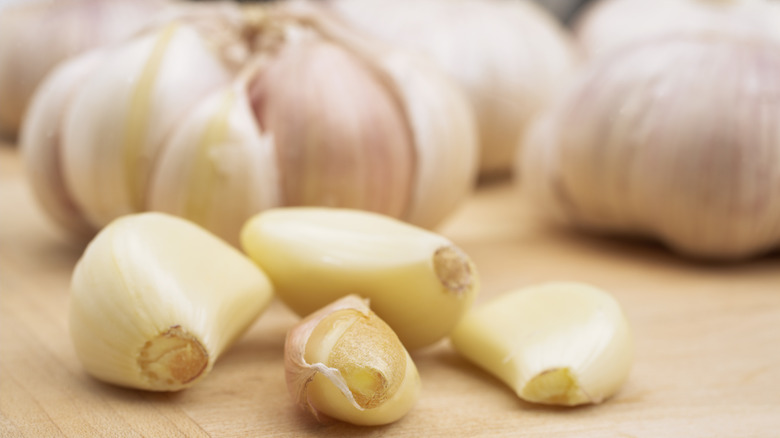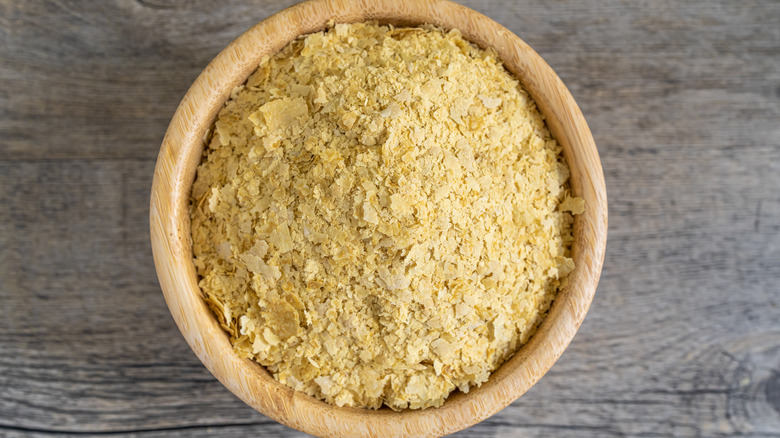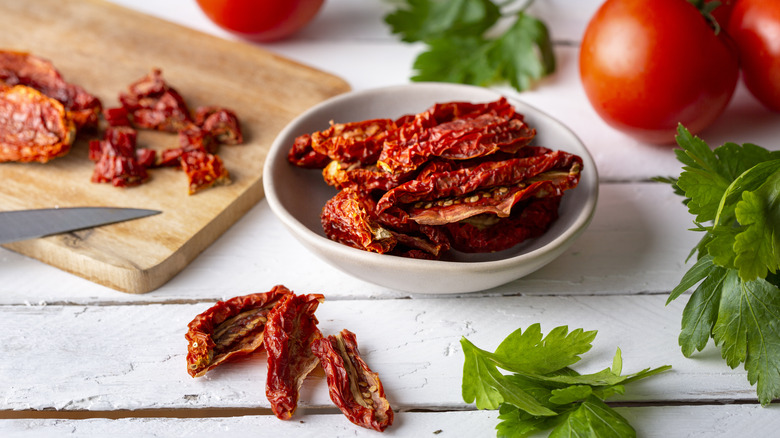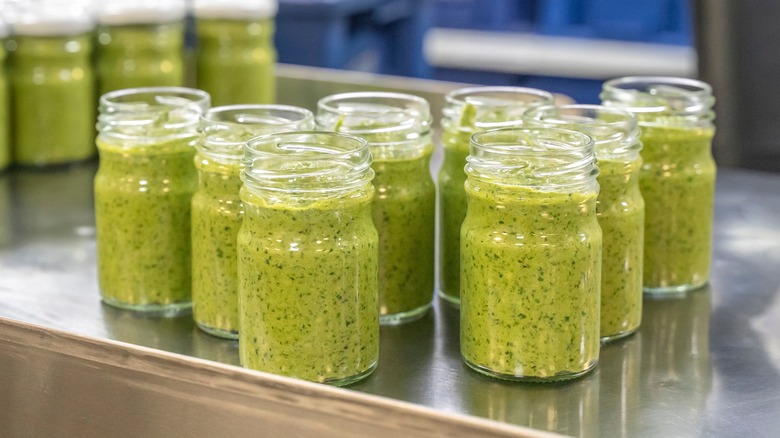14 Ways To Add More Flavor To Store-Bought Pesto
Store-bought pesto is a fantastic way to level up a weeknight meal. Since a standard pesto recipe contains fresh basil, pine nuts, garlic, salt, grated Parmesan cheese, and olive oil blended together, a premade variety offers an easier path to enhance countless dishes including pasta, pork chops, and pizza.
Now, just as numerous variations on the classic pesto recipe exist, there are plenty of brands on the market that sell ready-to-eat jars of the green sauce. You might even have one stashed away in your pantry. Of course, if you feel your store-bought pesto needs a bit more acid, salt, or zing, you can incorporate any number of unique additions to vitalize your premade pesto and transform it into something distinctive.
From capers to cashews, a range of options are available to help make any store-bought pesto taste even more incredible. Your family will never guess it was from the grocery store once they taste your embellished variation. Here are 14 ways to add more flavor to store-bought pesto.
Upgrade with a drizzle of olive oil
The precise oil included in jarred pesto sauces ultimately depends on the brand, though it can vary from olive oil to sunflower oil. No matter what type of oil is used in your store-bought variety, a bit of high-quality olive oil will impart additional flavor in a jiffy. This upgrade can make a big difference because many olive oils have their own unique flavor profile, whether it's peppery, spicy, or grassy (among others).
Olive oil can give store-bought pesto a much-needed boost — especially if you have a nice extra-virgin or infused variety (such as basil or garlic) on hand. Furthermore, you don't have to add much to make a difference. There's a good amount of oil already contained in a standard pesto sauce, after all, so you'll want to remove some already-contained oil beforehand to ensure it isn't too, well, oily.
Thankfully, this should be fairly easy to do. Oil tends to separate in many store-bought pesto brands, so simply spoon out a bit from the top of the jar and replace it with an equal amount of your desired olive oil. You'll quickly see how well it elevates the taste.
Bring a touch of heat
Since store-bought pesto is produced for the masses, the average premade version doesn't usually contain a spicier aspect. If you'd like to add a bit of spiciness without any chopping, a sprinkle of red chili pepper flakes can do the trick. The flakes blend flawlessly with the other bits of basil and Parmesan cheese. This energizing pesto add-in also brings a touch of heat without making the sauce rip-your-tongue-out spicy and works nicely with the herbal taste of the basil.
A lot of spicy pesto varieties available at the store are red pesto, so this is a great way to mix up your standard, green basil pesto instead. You can elevate the flavor of your pasta sauce with a spicy pesto, but it also works beautifully on sandwiches, drizzled on top of pizza, or added to fried eggs. You could also make jalapeño the star of pesto by roasting it on the stove for a smoky and spicy sauce that complements a variety of savory dishes.
Pour in a bit of acid
Perhaps you popped open a jar of pesto and felt it needed some rounding out with a hint of acid. Whether it's white vinegar, red wine vinegar, lemon juice, or another option altogether, integrating some acid can up the intensity of your pesto sauce. It's particularly helpful since the texture and flavor of jarred pesto sauces varies greatly from brand to brand. Even though you can compare ingredients on the back, there's no way to know just how much of any one ingredient is truly added.
When you want to give your store-bought pesto some further complexity, any number of acidic components can transform it from a somber sauce into a peppy pesto. Keep in mind: You don't want to clobber pesto with extra acidity, so start with a splash, and add more as needed. Also, be aware of how much pesto you're planning to use. A spritz of lemon juice should suffice for a couple of spoonfuls, while a whole jar will likely need more.
In fact, while other acid sources will work, lemon is the key to keeping pesto looking vibrant – particularly for leftover pesto that you want to use later. In other words, lemon juice may be the best acid to add, and it may even help extend the shelf-life of an opened jar of store-bought pesto in the fridge.
Shape it with heavy cream
You might want a smoother pesto sauce when making certain dishes. If so, you can thin out store-bought pesto without sacrificing flavor by using heavy cream. Cream adds more liquid to pesto so it won't thicken, and can be particularly helpful when you want a thinner, looser sauce to stir into potatoes, drizzle onto a hearty soup, or seamlessly spread over roasted veggies. Cream can even transform pesto into something that easily mixes into pasta without having to heat it first.
Heavy cream add a milky smoothness that's different than what you'll get with olive oil (which is likely more slick). Olive oil also has a viscosity that you can often feel in your mouth, whereas the velvety quality of heavy cream will instead turn pesto into an interesting, spreadable sauce. Pour out your jar of pesto and mix it with the heavy cream. It's up to you how much cream you want in the pesto, of course, but consider starting with a little rather than a lot. You can always add more based on the desired consistency.
Integrate some green vegetables or fresh herbs
Basil is the standard base of pesto, but you can always integrate more greens into the mix. If you happen to have fresh basil on hand, it doesn't hurt to chop it up and toss it into the sauce for some additional flavor and texture. It'll make your pesto more potent, fragrant, and colorful.
But you don't have to stop at basil. You can utilize other fresh herbs or green vegetables as a way to give your store-bought pesto a delightful complexity. There are many green-adding pesto options out there, such as this pea pesto recipe with ricotta, or this easy broccoli pesto that's perfect with chicken. Arugula is another solid choice that will bring a bitter, spicy sharpness to an otherwise rich product (and potentially even it out). Try spreading arugula pesto on a delicious turkey sandwich.
Parsley, cilantro, sage, and spinach are all fantastic options, as well — though be sure limit yourself to one or two additional ingredients when taking this culinary route. Additionally, no matter which greens you end up using, opt for fresh rather than dried or frozen varieties. Frozen spinach may be delicious, but it's far too watery to mix in raw (whereas fresh spinach pesto tastes great on pizza).
Incorporate additional nuts or seeds
Did you know that pine nuts are technically seeds? (You do now.) No matter its classification, pine nuts are a well-known ingredient in the average pesto. With that in mind, you should consider using other nuts and seeds to add more flavor to store-bought varieties.
There are several options to choose from when considering the best pine nut substitutes for pesto. Pistachio maintains the green theme while offering a welcome earthiness to the sauce (and tastes amazing with chopped grilled steak). Meanwhile, walnuts bring a rich, slightly bitter flavor that can work nicely in conjunction with pine nuts already found in jarred pesto brands.
Sunflower seeds will work, as well, given they're milder taste (and the fact that some store-bought pesto already has sunflower oil). You can also enhance the creaminess with cashews or alter the flavor with macadamia nuts, which makes for a great crust for chicken or fish. To do this, start by blending the nuts into a paste in a food processor or blender, then mix it in with your pesto. You can even toast nuts in the oven or on the stovetop before adding them to give extra depth to the final pesto product.
Swirl in flavored salt
If your store-bought pesto is lacking saltiness, give it an upgrade with a bit of sea salt, or even a flavored salt. Flavored salt is one of the quickest ways to upgrade any store-bought pesto since you just sprinkle, mix, and you're ready to serve. You don't want to oversalt the pesto, of course, so start by dusting a very small amount and add more to the pesto to taste.
Garlic salt is a fantastic choice. Its two-for-one flavor profile means you don't have to chop up garlic cloves — and leave your fingers reeking for hours after. A habanero salt or ghost pepper salt can provide spice when you want to feel a bit of fire on your tongue, and is a delightful choice to dress up pasta salad or spread on toast alongside a fried egg.
There's a whole range of other herb-infused salts that can give layers of flavor without a lot of effort, as well. Basil salt is a no-brainer for basil pesto, but rosemary salt can give your pesto a peppery taste that's ideal for meat dishes or a potato salad. Chipotle salt or smoked salt can bring a tasty smokiness that goes wonderfully with grilled chicken, steak, and veggies. Or mix a bit of truffle salt in to create truffle pesto and turn the simplest pasta dish into a sophisticated one.
Scoop in a small amount of mayonnaise
Mayonnaise and pesto? If you're feeling a bit dubious about this particular avenue for adding flavor to store-bought pesto, consider this tip is from someone you might recognize. Mayo is the creamy ingredient Ina Garten uses for decadent pesto pasta, in fact, and we're sure you'll inevitably scarf it down, too, once you try it. Since mayonnaise is usually made with a bit of egg yolk, vinegar or lemon juice, and oil, it's not nearly as bizarre as you might initially think as a pesto ingredient.
The mayonnaise thickens pesto sauce and results in a creamier finish that you can use on pasta, sandwiches, and more. Mix mayonnaise and the jarred pesto together thoroughly (until no visible mayo chunks remain), though it should come together easily to create a buttery sauce. The mayo evens out the consistency of pesto and becomes spreadable for whatever you desire.
You could use mayo-enhanced store-bought pesto as an aioli-adjacent dip for raw carrots, bell peppers, or celery. Try drizzling it over your favorite salad as a lip-smacking dressing and turn a basic salad into a creamy, herby delight.
Impress with additional cheeses
Parmesan is a classic ingredient in pesto. But there are many other types of cheese found throughout the world. In other words, when you don't have any Parmesan on hand and want to complement store-bought pesto with a different option, there's no shortage of cheeses you can use instead of Parmesan for pesto.
Now, something like mozzarella or cheddar will melt, particularly when mixing it with a heated hot ingredient like pasta, and may mess up the sauce's texture. As a result, Pecorino Romano makes a top alternative — and is often paired with Parmesan already since they're both hard, dry cheeses. Simply grate the cheese into your store-bought pesto, mix it together, and enjoy.
Another option is manchego cheese. It isn't as dry as Parmesan, but can give store-bought pesto an appreciated richness and zest that complements the ingredients found in many jarred brands. It also has a crumbly texture that fits with the texture of the Parmesan, garlic, and basil in pesto.
Transform with capers
Capers might be the game-changing ingredient you should add to your pesto forevermore — store-bought or otherwise. Capers add a savory and briny component that can bring that something extra your pesto is missing. Blend capers with a bit of the liquid from the jar in a blender or food processor until it becomes a paste — one that can be effortlessly mixed into the pesto. Blending not only allows for a seamless integration but more evenly distributes the flavor, as well.
The flavor profile of capers parallels other ingredients in pesto. Plus, it's the same color as basil, so it blends in beautifully aesthetically-speaking. You won't even know it's there outside of the sauce's improved taste. Spread caper-boosted pesto onto a piece of sourdough bread with turkey, tomatoes, cheese, and spinach to create a mouthwatering sandwich.
Capers also pair wonderfully with smoked salmon or a white fish like mahi-mahi, and the same can be said of pesto. Simply cook the fish as you normally would before slathering on caper pesto, and you're ready to serve. If you want a bit of pop, leave some capers whole or lightly chopped to bring some additional texture (though this is definitely a personal preference).
Elevate with a little extra garlic
Garlic is one of those foods that enhances just about anything it touches. When you feel like your jarred pesto is missing robustness, don't hesitate to add some minced garlic into the mix. There's likely some garlic already in the jar, and minced or grated garlic is often the same size as the little Parmesan pieces (so it combines quite easily).
The garlic level and texture of store-bought pesto will range dramatically depending on the brand you purchase — so taste yours beforehand to see what it needs. Use freshly minced as opposed to pre-minced jarred garlic or dried garlic powder for a full-bodied taste. You can also try roasting a head of garlic to turn it into an incredibly easy-to-smoosh clove that's also more mellow than raw garlic. A scoop of garlicky pesto tastes great in a bowl of hummus and acts as an incredible seasoning mixture for grilled shrimp.
Transform the taste with nutritional yeast
Nutritional yeast is a common addition to vegan foods because it provides a slightly cheesy and umami taste. Not only that, but nutritional yeast is a dairy and gluten free way to get a nutritional boost since it contains protein, fiber, and other vitamins and minerals. The specific nutrients included will vary by brand, so it's something to keep an eye on when buying a product. Either way, nutritional yeast's nuttiness works well when combined with pine nuts and the cheesiness of Parmesan.
Grind the flakes in a mortar and pestle to turn them into a fine powder before mixing it in with store-bought pesto. Since you can turn savory scones into something special with pesto, don't hesitate to use this version to make a dynamic baked good for your afternoon a cup of tea. Spread nutritional yeast pesto on a veggie wrap or add it to avocado toast. It can enhance the cheesiness of a bagel and cream cheese, and works nicely as the base of an artichoke tomato pesto flatbread.
Blend in sun-dried tomatoes for taste and color
While there are entire versions of red pesto — or pesto rosso – we're more interested in adding flavor to store-bought pesto with sun-dried tomatoes. After all, while pesto rosso involves replacing basil entirely with sun-dried tomatoes, we're here to incorporate it into a classic basil-based store-bought pesto. The distinct herb and peppery flavor of basil works beautifully with the earthy, slightly sweet sun-dried tomatoes.
Now, there's a difference between dry sun-dried tomatoes and those packed in oils, including how hydrated they are. For a jarred pesto, then, we recommend oil-packed sun-dried tomatoes as they'll partner beautifully with the oil in pesto. Take the sun-dried tomato out of the oil or use a paper towel to remove any excess oil. The texture will be chewy but not tough.
You can use dry sun-dried tomatoes, as well, though be sure to hydrate them in a salted liquid to soften them beforehand. Finely chop the sun-dried tomatoes or run them through your food processor with a bit of oil or the salted liquid. Once it turns into a paste, mix it in with the store-bought pesto and use it to make a delicious batch of sun-dried tomato pesto pasta.
Don't forget to minimize its exposure to heat
Pesto's flavor degrades when exposed to heat, so you should think twice before cooking pesto – homemade or store-bought. The basil, lemon juice, and olive oil can quickly take a turn for the worse in terms of taste when faced with extreme heat. Instead of heating it on the stove like other types of pasta sauce, simply mix pesto into or on top of your already warmed dish.
Pesto only needs a minute or so to warm up before serving, after all — particularly when working with a room temperature, unopened jar of pesto. Even if you're using a refrigerated pesto (whether or not it's been opened previously), you don't want to heat it for any sort of prolonged period or fully simmer pesto on the stove.
If you have boiled and drained pasta, add the pesto and allow it to warm up through the pasta's heat as you're about to serve it. The same idea goes for baked fish such as tilapia. Once the tilapia is fully cooked, plate it, and spoon some pesto onto it or coat the fish. No matter how you use it, this might be the most fundamental tip of all when it comes to adding flavor to store-bought pesto: never heat or cook your pesto sauce.
